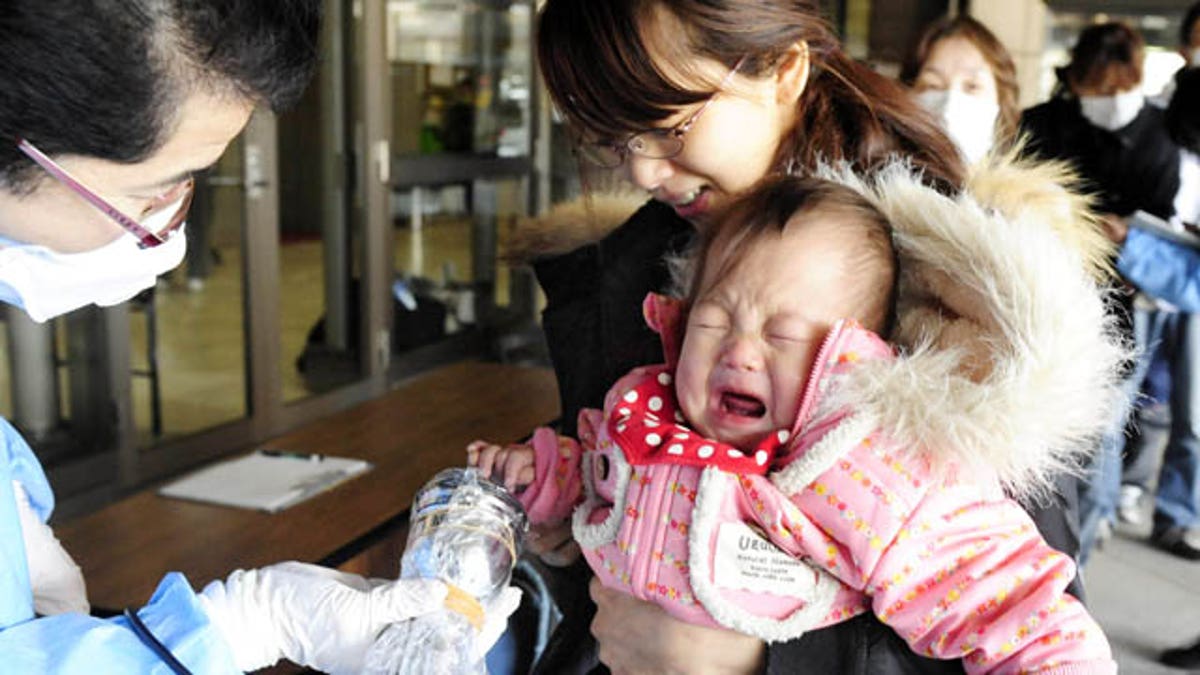
March 17: A baby cries as she is helped by her mother to be screened for radiation exposure before entering an evacuation center in Fukushima, northern Japan. (AP/Kyodo News)
As U.S. Customs and Border Protection officials screen sea and air traffic from Japan for radiation, the Federal Aviation Administration is "actively coordinating" with Japanese authorities to ensure international flight paths are well clear of the country's damaged nuclear reactors.
"Out of an abundance of caution, CBP has issued field guidance reiterating its operational protocols and directing field personnel to specifically monitor maritime and air traffic from Japan," read a statement obtained by FoxNews.com. The CPB referred to its use of "several types of radiation detection equipment in its operations at both air and sea ports" to assess safety risks "that are identified with inbound travelers and cargo."
Should travelers show signs of radiation sickness, the CBP will refer them to health authorities for "appropriate treatment," the statement said.
The Obama administration said Thursday that radiation leaking from the Japanese nuclear complex does not present a danger to the western United States or its Pacific territories at this time.
"I want to stress this is a prudent and precautionary measure to take," Gregory Jaczko, chairman of the Nuclear Regulatory Commission, told a White House briefing.
The proposed 50-mile evacuation zone recommended by the U.S. is far wider than that established by Japan, which has called for a 12-mile zone and has told those within 20 miles to stay indoors.
Department of Homeland Security Secretary Janet Napolitano said no radiation contamination had been found in the U.S. as of Thursday, but reiterated that the aviation and maritime checks would continue.
Federal aviation officials, meanwhile, continue to coordinate with Japanese civil aviation authorities to ensure that problems associated with the stricken nuclear reactors do not jeopardize air travel safety.
FAA spokeswoman Tammy Jones told FoxNews.com that the "FAA is actively coordinating with the Japanese civil aviation authority and the other U.S. government agencies working on this issue to identify hazards to civil aviation posed by the damaged reactors at the Fukushima nuclear power plant."
Radiation continues to leak from the crippled reactors, leading Japanese officials to create a no-fly zone over the facility.
On Tuesday, the Comprehensive Test Ban Treaty Organization, an arm of the United Nations in Vienna, released a forecast of the possible movement of the radioactive cloud emanating from the Japanese reactors. According to the projection, which provided no information on actual radiation levels, the plume would cross the Aleutian Islands on Thursday before hitting southern California sometime on Friday.
If the situation worsens, FAA officials have said the agency is prepared to reroute air traffic if necessary.
Two days earlier, the United States Nuclear Regulatory Commission said it expected no harmful levels of radiation from Japan to reach the United States due to the vast distance between the two countries.
That expectation, however, hasn't stopped pilots from closely monitoring the radioactive cloud.
Capt. Sam Mayer, a spokesman for the Allied Pilots Association, which represents more than 10,000 American Airlines pilots, said extra fuel is being added to U.S. flights from Los Angeles, Dallas, Chicago and New York to Japan in case emergency diversions are necessary.
"In terms of actual radiation, they're putting together flight patterns to keep them well-clear of any potential hazardous areas and they're putting extra gas on the planes," Mayer said. "A lot can happen while the plane is airborne."
Mayer said he's monitoring the situation "minute by minute" and that contingency plans are in place should it take a turn for the worse.
"We have a plan to get everybody out of the area quickly and get them back here," he said. "The only thing we've been told is that the FAA is working with Japan counterparts to develop these [contingency] models."
The Associated Press contributed to this report.

